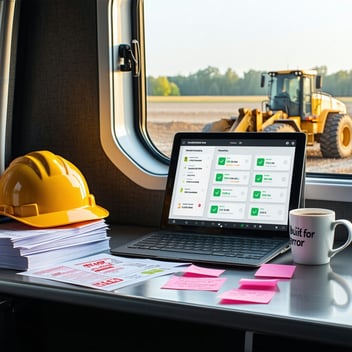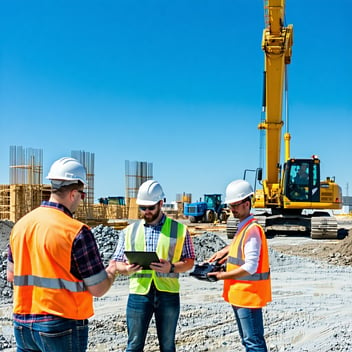You’ve got crews clocking in from four jobsites, three union classifications, and one incorrect timecard could trigger a chain reaction of wrong wages, blown budgets, missed WH-347 compliance. Sound familiar?
Payroll in construction isn’t like payroll in retail or tech.
With numerous regulations, constantly changing workloads and job sites, and unreliable connectivity, general contractors can’t rely on just any payroll system to get the job done.
The wrong system can lead to payroll delays and budget issues. Payroll mistakes are costly and can cause a ripple effect of compliance fines, job costing inaccuracies, or frustrating delays.
Not all payroll software is built for construction — and choosing the wrong one can cost you. Below, we’ll explore why construction payroll is so complex and the features general contractors should look for in a payroll system, like hh2 Remote Payroll.
Why is Construction Payroll Complicated?
Payroll in any company and industry brings challenges, but construction payroll is especially complicated.
To start, construction brings variability in labor, location, and task — often changing every day. Employees and teams can work at a different job site every day or week and bounce between different schedules, tasks, and types of work — all of which need to be coded and processed differently for payroll. Time also needs to be allocated to cost codes and job numbers. It’s not just a matter of knowing who is working where but applying the right codes to their payroll. Those codes have a ripple effect on job costing and future budgets, so accuracy is crucial.
With teams and employees working at various job sites, gathering accurate time data can be challenging. Many construction sites are remote, so it can be difficult to collect real-time time-tracking data. Many companies still rely on outdated manual time tracking and data collection because of the complexities, but those practices open the door to delays and errors.
Construction also faces many payroll regulations. Union employees under collective bargaining agreements (CBAs) must have the wages and working conditions set in their contract. A general contractor can work with employees in many different unions, each with a unique CBA, and must process payroll accordingly. Projects funded by the government also must comply with prevailing wage laws, including pay rates that may differ from those in other projects. Certified payroll requirements, such as form WH-347 and state formats, require additional calculations and coordination.
All this is to say that construction payroll is incredibly complex and nuanced. Regardless of whether a general contractor is managing payroll for five employees or 500, managing these complications can be difficult.
Do You Need Construction Payroll Software?
Even with all the complexities of construction payroll, many general contractors will opt for generic payroll software. And while this basic tool may seem to get the job done at first, it can lead to difficult processes and regulatory challenges along the way.
If any of these red flags sound familiar, it’s time to switch from general payroll software to a system designed for construction:
It doesn’t handle job costing or multiple pay rates
Payroll doesn’t just affect current projects —it also impacts budgets and projections for future projects. If your payroll system can’t handle job costing, it can seriously impact the accuracy of future budgets, which can hurt your planning.
It requires manual data transfer from timekeeping systems
Moving data manually between systems is repetitive and time-consuming, not to mention it creates opportunities for errors to occur. A payroll platform that requires manual data entry is slowing you down, which limits how fast you can process payroll.
It doesn’t integrate with ERPs
General contractors typically use multiple systems to track their business. But if a payroll system doesn’t integrate with an enterprise resource planning system like Sage 300, Vista, or Foundation, you’re missing out on crucial insights.
It doesn’t support certified payroll reporting or union deductions
One of the most common challenges of construction payroll is union and certified wages. A system that doesn’t support these complications means contractors have to perform manual calculations or risk falling out of compliance with inaccurate wages.
Key Features of Construction Payroll Software
Even switching to a construction payroll system isn’t a guarantee that the software will automatically fit your needs. When considering payroll software options, look for these key features:
- Mobile-friendly time capture tools. General contractors know that work happens at all sorts of job sites. Look for offline and onsite payroll software so workers can accurately capture their time from anywhere on a mobile device. hh2’s Remote Payroll has field-first time capture on mobile app or web, providing workers and supervisors with a quality and reliable time tracking experience.
- Real-time sync. Payroll doesn’t exist in a bubble. It connects with ERP and accounting projects, so your payroll software should easily sync and integrate with those systems for the most current information. hh2 Remote Payroll delivers two-way integration with Sage, Vista, and other popular platforms to seamlessly move data back and forth between systems.
- Union and prevailing wage compliance support. Union and prevailing wages are among some of the most common human resources and construction payroll challenges and are unique from any other industry. A robust payroll software understands the challenges and provides support. Remote Payroll offers automated certified payroll and multi-rate pay support, so general contractors can easily have all of their questions answered.
- Certified payroll automation. Manually calculating and processing payroll can be time-consuming. Many construction payroll tools automate much of the process, including complex WH-347 forms.
- Cost code accuracy and job-based labor tracking. The accuracy of payroll impacts budgets and job costing. Look for a payroll system that ensures accuracy and flags potential errors so you can fix problems before they become larger issues.
- Supervisor approval workflows built for the field. The best payroll software offers customizable approval workflows so supervisors can easily track and approve time cards and payroll, no matter where they're working. Remote Payroll gives supervisors mobile-ready tools to approve timecards fast — no email chains or missed hours.
hh2 Remote Payroll is a cloud-based, secure, and scalable platform trusted by over 3,600 contractors. Built specifically for construction, our software provides all the tools and support general contractors need to streamline payroll.
“We used to spend 15 hours a week fixing timecards. Now, payroll is done before lunch — accurate, compliant, and approved.” - Controller, Mid-Sized GC in Texas
Transform Payroll with Construction Software
If you're self-performing work and managing complex labor, the right payroll software isn’t optional — it’s foundational. hh2’s Remote Payroll can transform how you process and calculate payroll, ensuring accuracy and efficiency. hh2’s Remote Payroll is a purpose-built solution for GCs who self-perform work and need to integrate field data, labor classifications, compliance, and ERP syncing.
Stop settling for software that wasn’t built for your business. Discover how hh2’s Remote Payroll simplifies construction payroll from the field to the back office. Explore Remote Payroll.
Supercharge Your Back-Office
Eliminate manual data entry and manual errors while simplifying nearly every back-office process with hh2's construction solutions.
Blog Transcript



